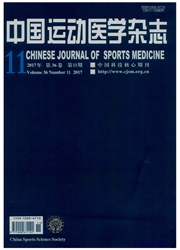

 中文摘要:
中文摘要:
目的:观察世居高原中长跑运动员高住低练(living high training low,HiLo)期间血清EPO、sTfR及血象指标变化,探讨HiLo训练对世居高原耐力项目运动员红细胞生成的影响。方法:随机将20名世居海拔2260m高原的中长跑运动员(男12名,女8名)分成低氧组和对照组,每组10名(6男,4女)。低氧组在模拟海拔4000m低压低氧(大气压力为60kPa,氧气浓度为20.95%)环境下进行HiLo实验,每天低氧暴露10小时(8:00pm~6:00am),白天在其居住生活的海拔2260m高度进行训练;对照组睡、练均在海拔2260m环境。两组受试者实验期间的训练负荷、时间及营养状况均相同。实验进行4周。分别于实验前,实验开始1天、每周及实验结束后2周抽静脉血,测试血清促红细胞生成素(EPO)、血清转铁蛋白受体(sTfR)及血红蛋白(Hb)、红细胞压积(Hct)。结果:4周HiLo后,低氧组运动员Hb、Hct较实验前无明显改善(P〉0.05),EPO除在低氧暴露第1天比实验前有升高趋势(P〈0.10)外,整个实验期间与实验前及对照组相比均无显著性改变;HiLo训练后低氧组sTfR与实验前和对照组相比也未发生有统计意义的变化。结论:世居高原(海拔2260m)中长跑运动员进行4周HiLo训练对其EPO、sTfR、Hb升高作用不显著,表明世居高原中长跑运动员4周HiLo训练(模拟海拔4000m睡眠,海拔2260m训练)对机体红细胞生成影响不明显。
 英文摘要:
英文摘要:
Aim In present study,we aimed to verify whether erythropoiesis were modified by 'living high and training low'(HiLo)and explore the physiological effects of HiLo on mid-long distance runners from plateau natives.Methods Twenty mid-long distance runners who were natives of plateau(altitude of 2260m)were randomly divided into hypoxic group(n=10)and control group(n=10).Runners in hypoxic group stayed at the altitude of 4000m(10h per day) and trained at the altitude of 2260m for 28 days,and runners in control group stayed and trained at the altitude of 2260m.All subjects were tested before experiment,in the first day of hypoxic experiment,by the end of experiment,and 2 weeks after HiLo experiment.Results After 4-week HiLo,Hb,Hct and sTfR were not significantly increased as compared with those before HiLo in both hypoxic and control groups.Serum EPO also increased insignificantly in the process of HiLo experiment,except somewhat elevation(P 0.05)in the first day of experiment in hypoxic group.Conclusion Results showed that erythropoiesis,including EPO secretion,sTfR,and Hb in mid-long distance runners who were natives of plateau were not affected by HiLo.
 同期刊论文项目
同期刊论文项目
 同项目期刊论文
同项目期刊论文
 期刊信息
期刊信息
